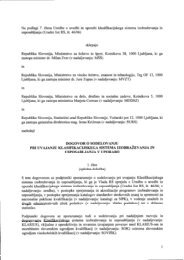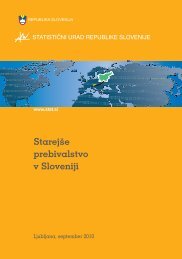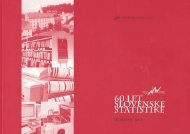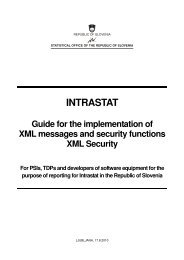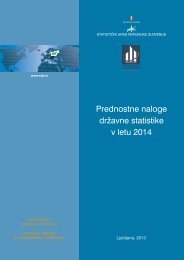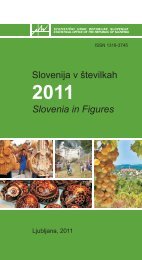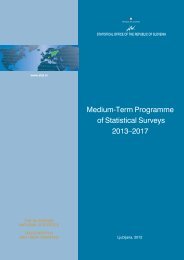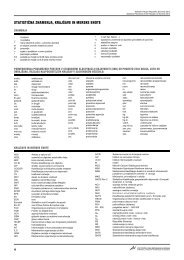Slovenske regije v Å¡tevilkah - StatistiÄni urad Republike Slovenije
Slovenske regije v Å¡tevilkah - StatistiÄni urad Republike Slovenije
Slovenske regije v Å¡tevilkah - StatistiÄni urad Republike Slovenije
You also want an ePaper? Increase the reach of your titles
YUMPU automatically turns print PDFs into web optimized ePapers that Google loves.
Kohezijska regija Vzhodna Slovenija<br />
Ogledalo <strong>regije</strong><br />
[ifra, ime statisti~ne <strong>regije</strong> / Code & name of statistical region<br />
01 Pomurska<br />
02 Podravska<br />
03 Koroška<br />
04 Savinjska<br />
05 Zasavska<br />
06 Spodnjeposavska<br />
07 Jugovzhodna Slovenija<br />
10 Notranjsko-kraška<br />
Vzhodna Slovenija obsega okrog 12.000 km 2 . Njena lega<br />
na sti~i{~u Alp, Panonske ni‘ine ter Dinarskega gorovja se<br />
odra‘a v veliki pokrajinski raznolikosti <strong>regije</strong>; severozahodni<br />
alpski del se proti vzhodu ni‘a v vinorodna gri~evja na robu Panonske ni‘ine, proti jugu pa v<br />
kra{ko Dinarsko gorstvo. Zaradi redko poseljenih obmejnih obmo~ij in ve~jih gozdnatih predelov<br />
je gostota poseljenosti tukaj ni‘ja od povpre~ne v dr‘avi. V gospodarskem pogledu velja ta regija<br />
za manj razvito. Zaznamuje jo kmetijska dejavnost, saj se tukaj nahaja ve~ kot 70 % kmetijskih<br />
gospodarstev in ve~ji del kmetijskih zemlji{~. Kljub temu pa kmetijstvo malo prispeva k bruto<br />
dodani vrednosti (BDV). Veliko ve~ prispeva industrijska dejavnost (okrog 40 %), in sicer zdru‘uje<br />
tradicionalne in moderne panoge (rudarstvo, tekstilna, avtomobilska, farmacevtska ter<br />
elektrotehni~na dejavnost). Zaposleni v tej regiji ustvarijo ni‘ji bruto doma~i proizvod in imajo<br />
ni‘je pla~e kot zaposleni v Zahodni Sloveniji, dele‘ brezposelnih med aktivnimi prebivalci pa je v<br />
tej regiji ve~ji. Ta regija ima pomembno vlogo pri energetski oskrbi dr‘ave, saj se na njenem<br />
ozemlju poleg edine jedrske elektrarne nahaja ve~ina energetske infrastrukture. K njeni<br />
prepoznavnosti prispevajo tudi bogata naravna dedi{~ina kra{kega podzemlja, termalni izviri,<br />
tradicionalni pustni obi~aji z znanim pustnim likom kurentom ter najstarej{i doma~i obrti –<br />
suhorobarstvo in lon~arstvo.<br />
Vzhodna Slovenija covers around 12,000 km 2 . Located at the meeting point of the Alps, the<br />
Pannonian Basin and the Dinaric Mountains it reveals diverse landscapes as its north-west Alpine<br />
ridge descends into the wine-growing hills at the edge of the Pannonian Plain in the east<br />
and lowers into the karstified Dinaric Mountains towards the south. The population density is<br />
due to sparsely populated border areas and some large uninhabited areas covered with forests<br />
below the national average. In terms of economy, the region presents a less developed part of<br />
Slovenia. More than 70% of Slovene farms located within it and a high share of arable land<br />
show the importance of agriculture, although a low share of the gross value added (GVA) is<br />
derived from it. The industrial sector comprises traditional and modern industrial branches (mining,<br />
textile, car, pharmaceutical, electronics and electrical appliances), contributing around 40%<br />
to the GVA. Gross domestic product and earnings of persons employed are in this region lower<br />
than in Zahodna Slovenija, while the unemployment rate is higher. With most of the power<br />
plant infrastructure, including the only nuclear power plant in Slovenia, the region is the country’s<br />
energy supplier. The region is not known only for its natural heritage such as the underground<br />
Karst world and thermal springs, but also for its traditional Shrovetide festivities with Kurent as<br />
the most famous figure and traditional handcrafts as woodenware and pottery.<br />
Povr{ina, km 2 , 31. 12. 2008 12.212<br />
Area, km 2 , 31. 12. 2008<br />
[tevilo prebivalcev, 31. 12. 2008 1.081.307<br />
Population, 31. 12. 2008<br />
Gostota prebivalstva, 31. 12. 2008 88,5<br />
Density of population, 31. 12. 2008<br />
Prebivalci, stari 0–14 let, %, 31. 12. 2008 13,8<br />
Population aged 0–14, %, 31. 12. 2008<br />
Prebivalci, stari 65 let ali ve~, %, 31. 12. 2008 16,4<br />
Population aged 65 or over, %, 31. 12. 2008<br />
Indeks staranja, 2008 119,3<br />
Ageing index, 2008<br />
Povpre~na starost prebivalcev, 31. 12. 2008 41,4<br />
Mean age of population, 31. 12. 2008<br />
[tevilo `ivorojenih, 2008 10.943<br />
Number of live births, 2008<br />
[tevilo umrlih, 2008 10.527<br />
Number of deaths, 2008<br />
Naravni prirast na 1.000 prebivalcev, 2008 0,4<br />
Natural increase per 1,000 population, 2008<br />
Skupni prirast na 1.000 prebivalcev, 2008 3,9<br />
Total increase per 1,000 population, 2008<br />
Letna stopnja rasti, ‰, 2008 5,5<br />
Annual population growth rate, ‰, 2008<br />
[tevilo u~encev, 2008/09 1) 85.944<br />
Number of pupils, 2008/09 1)<br />
[tevilo dijakov, 2008/09 1) 47.179<br />
Number of upper secondary school pupils, 2008/09 1)<br />
[tevilo {tudentov, 2008/09 1) 58.097<br />
Number of tertiary students, 2008/09 1)<br />
Prebivalci, stari med 25–64 let, z najve~ osnovno{olsko izobrazbo, %, 2008 20,4<br />
Population aged 25–64 with elementary education or less, %, 2008<br />
Prebivalci, stari med 25–64 let, s srednje{olsko izobrazbo, %, 2008 61,2<br />
Population aged 25–64 with upper secondary education, %, 2008<br />
Prebivalci, stari med 25–64 let, z vi{jo ali visoko izobrazbo, %, 2008 18,4<br />
Population aged 25–64 with tertiary education, %, 2008<br />
[tevilo delovno aktivnih prebivalcev, 2008 426.052<br />
Number of persons in employment, 2008<br />
[tevilo zaposlenih oseb, 2008 374.591<br />
Number of persons in paid employment, 2008<br />
60



